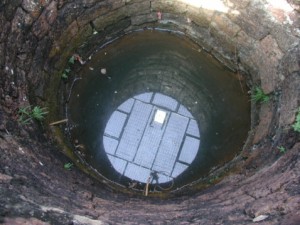Circus of Dreams (Part 22)
By Asher Crispe: December 14, 2012: Category Decoding the Tradition, Inspirations
To Light Up the Night
 According to the Jerusalem Talmud (Brachot 8:5), on the first day of Creation (before the Sun and the Moon were introduced on day four) the light shown for 36 hours. The Medieval kabbalist Rabbi Eleazer of Worms relates these 36 hours of this original light (that would eventually become hidden away for the future), to the 36 candles of Chanukah. Interestingly, the subsequent model for the day was diminished to just 24 hours (as we know only too well!) which means that the sum of these two configurations of hours in a day equal 60–the numerical value of the letter Samech whose circular form temporally contextualizes the Chanukah festival. In other words, the critical number of 36 candles exemplifies the intersection of a triangle of 8 and the square of 6 all happens within the time frame of the Samech-circle.
According to the Jerusalem Talmud (Brachot 8:5), on the first day of Creation (before the Sun and the Moon were introduced on day four) the light shown for 36 hours. The Medieval kabbalist Rabbi Eleazer of Worms relates these 36 hours of this original light (that would eventually become hidden away for the future), to the 36 candles of Chanukah. Interestingly, the subsequent model for the day was diminished to just 24 hours (as we know only too well!) which means that the sum of these two configurations of hours in a day equal 60–the numerical value of the letter Samech whose circular form temporally contextualizes the Chanukah festival. In other words, the critical number of 36 candles exemplifies the intersection of a triangle of 8 and the square of 6 all happens within the time frame of the Samech-circle.
Backing up a bit, we stated previously that Avraham/Abraham fathers Yitzchak/Isaac and that this genealogy has symbolic and metaphysical overtones of the shift from a mountain-vertical mindset to a field-horizontal mentality. What we did not yet explain were the reasons for Yitzchak’s/Isaac’s preference for the field in the first place. One plausible response would evoke the primary image of Yitzchak’s/Isaac’s spiritual pursuits: namely digging wells. While not the only digger of wells in the Torah (Avraham/Abraham also dug wells) he gets the credit for this as it divulges something of his inner character. As the antithesis of looking for God on High (atop a mountain), the well is tapped by drilling down below within the immanent sphere of reality. In this way, the well might be summarized as looking for transcendence below rather than above. To accomplish this we have to find that common denominator or shared plane of existence–for there we will release the pregnant potential within such a ‘ground’ state.
Another example of the field or square as an enclothment of possibilities (where two terms become four or two squared such as we mentioned with the masculine and feminine existing within both the masculine and feminine), can be found in the commentary of Rabbi Chaim ben Attar (1696-1743 as known as the Ohr Ha’Chaim) on Genesis 25:19 regarding the ‘generation’ of Yitzchak/Isaac. Following the teaching of the Zohar, he maintains that Yitzchak/Isaac was born into this world with a feminine soul. Then at the time of the Akedah (the binding of Yitzchak/Isaac), the esoteric tradition maintains that his feminine soul departed from his body and then was ‘resurrected’ as a masculine soul which enabled him to eventually marry Rivka/Rebecca. As a result, his soul experienced the interinclusion of feminine and masculine within the masculine with a kind of unparalleled intensity. The distinction semi-collapses or at least overlaps leading to the ‘field’ or ‘square’ thinking. Perhaps this also sheds light on why he was the only one of the patriarchs who had only one wife which is frequently cited as evidence of their ‘equal’ stature in Kabbalah.
Given the weight placed on this transition from pyramid to square, we should also call attention to other appearances of the same rarified phenomenon in the history of Torah thought. Astonishingly, there is another well-known rabbinically mandated custom that details how to perform the counting of the 49 days of the Omer (Sefirat Ha’omer) that takes place from the second day of Passover up until the holiday of Shavuot (literally ‘Weeks’: this festival marks the giving of the Torah on Mount Sinai). The first day of Shavuot then becomes the 50th day from the start of the count (but it is itself not counted, only the 49 intervening days are). Besides bridging the two holidays and historic events, the counting of the Omer marks the preparation and buildup to the revelation of Shavuot. While most think of it as a simple progression from 1 to 49 the Sages were exacting with the wording of the count: for instance, we do not say that ‘today is the second day’ of the Omer, today is the third day of the Omer” which would be an example of ordinal numbers. There is not a 1st, 2nd, 3rd day but rather “one day, two days, three days” and so on. We are dealing with cardinal numbers which means that we are actually constructing a pyramid with 49 levels to it.
Using our formula of triangular numbers once more:
n(n+1)/2
n = 49 (for the 49 days) Consequently:
49 (50)/2 = 1225
Hence, during the Omer period we are counting not 49 days but a triangle of 49 days or 1225 ‘days.’ Each subsequent day may be likened to a slightly more expanded state of consciousness (‘day’ usually symbolizes consciousness throughout the Torah). Therefore, with each new day, I am able to embrace or wrap my head around another ‘unit’ of consciousness. On day two I count ‘two days’ which means my mind can only handle two levels of consciousness but on the third day when I count ‘three days’, I can open myself to containing three levels. What is significant about this progression is that a complete triangle with 49 levels that gives us 1225 ‘days’ or ‘conscious states’ (as compared with Chanukah candles which also are illuminations of the mind) is that this number also converts into a square. 1225 is 35 squared!
49△ = 352
Now the wonder of it all is that there are no other numbers that have this quality of being a triangle that turns into a square between 36 (the Chanukah candles) and 1225 (the ‘days’ of the counting of the Omer). Clearly, this shared mathematical structure that was ‘encoded’ by the Sages is coming to inform us that there is an intrinsic relationship between the giving of the Torah and the festival of Chanukah. The simplest confirmation of this can be found in the statement in Proverbs 6:23 “for the commandment is the candle and the Torah is the light.” If we want to extract a reference to the mitzvot (commandments) that are the candles in this verse, then we can see its position of centrality in that the entire progression that is building up to the giving of the Torah on Shavuot with 1225 ‘days’ has 613 as its mathematical midpoint (612 before the 613 unit and 612 after or 612 + 1 + 612 = 1225). 613 of course is the exact number of commandments in the Torah. As the midpoint of the whole series, 613 would be the center around which the entire procession pivots–the commandants are ‘pivotal’ to the attainment of the Torah.
Lest, we think that this series ends here, the Arizal in the 16th century comes to extend it. One of the most important concepts in his teachings is the idea of there being RaPaCh [רפ’ח] nitzotzot or 288 ‘sparks’ that fell with Creation as a result of the ‘breaking of the vessels.’ Without going into the details of this kabbalistic description, we can suffice to say that reality requires repair because it has suffered the trauma of fragmentation. Each shard of reality contains some essential spark of Holiness. We could even assert that reality is ‘pregnant’ with these sparks (an allusion that is reinforced by the fact that 288 equals the word ibur [עיבור] or ‘pregnancy’ in Hebrew). The job of elevating these sparks falls to the righteous (tzadik) of each generation and also the aspect of the righteous one [tzadik] within each one of us.
Lifting up the sparks happens incrementally. In general, they have to make their way back up the Great Chain of Being back to their Divine source. Heaping them all together is like establishing a pyramid with 288 levels.
288 (289)/2
Gives us: 41,616
Incredibly, 41,616 is another example of a triangle that turns into a square.
2042 = 41,616
204 is the equivalent of the Hebrew word of the righteous one (tzadik: Tzadi [90], Dalet [4], Yud [10], Kuf [100]: צדיק) whose job it is to elevate the 288 sparks.
 Once again, there are no other numbers between 36 and 1225 and 41,616 that possess this quality of being both a triangle and a square. In modern mathematics, finding ‘square triangular’ numbers relates to Pell’s equation, but it clearly has a predecessor in the ancient rabbinic world. The use of mathematical relationships in rabbinical thought not only organizes ideas with great sophistication, it also cultivates an understanding of the psycho-spiritual dimensions of mathematics itself. Our triangles becoming squares denote hierarchies transforming into states of equality with regard to all three of the examples given above.
Once again, there are no other numbers between 36 and 1225 and 41,616 that possess this quality of being both a triangle and a square. In modern mathematics, finding ‘square triangular’ numbers relates to Pell’s equation, but it clearly has a predecessor in the ancient rabbinic world. The use of mathematical relationships in rabbinical thought not only organizes ideas with great sophistication, it also cultivates an understanding of the psycho-spiritual dimensions of mathematics itself. Our triangles becoming squares denote hierarchies transforming into states of equality with regard to all three of the examples given above.
For the conclusion of our series in Part 23, we will explain the correspondence of the circle to Ya’akov/Jacob and his son, Joseph, as well as highlight how our progression of the triangle, square, and circle relates to the secret of the dreidel (sevivon).
http://www.interinclusion.org/inspirations/circus-of-dreams-part-23/
http://www.interinclusion.org/inspirations/circus-of-dreams-part-21/
Circus of Dreams (Part 22),













;)
;)
;)
;)
;)
;)
;)
;)
;)
;)
